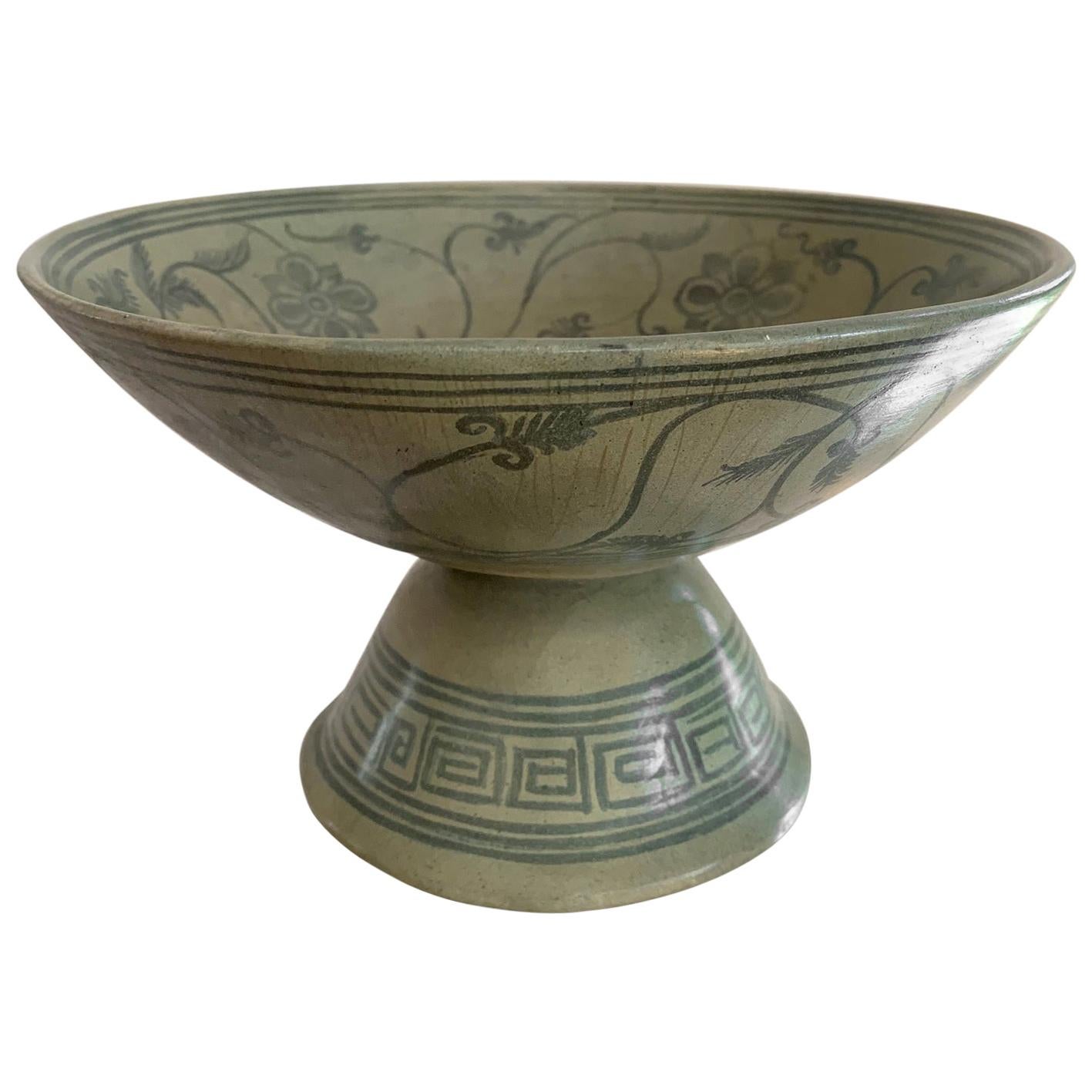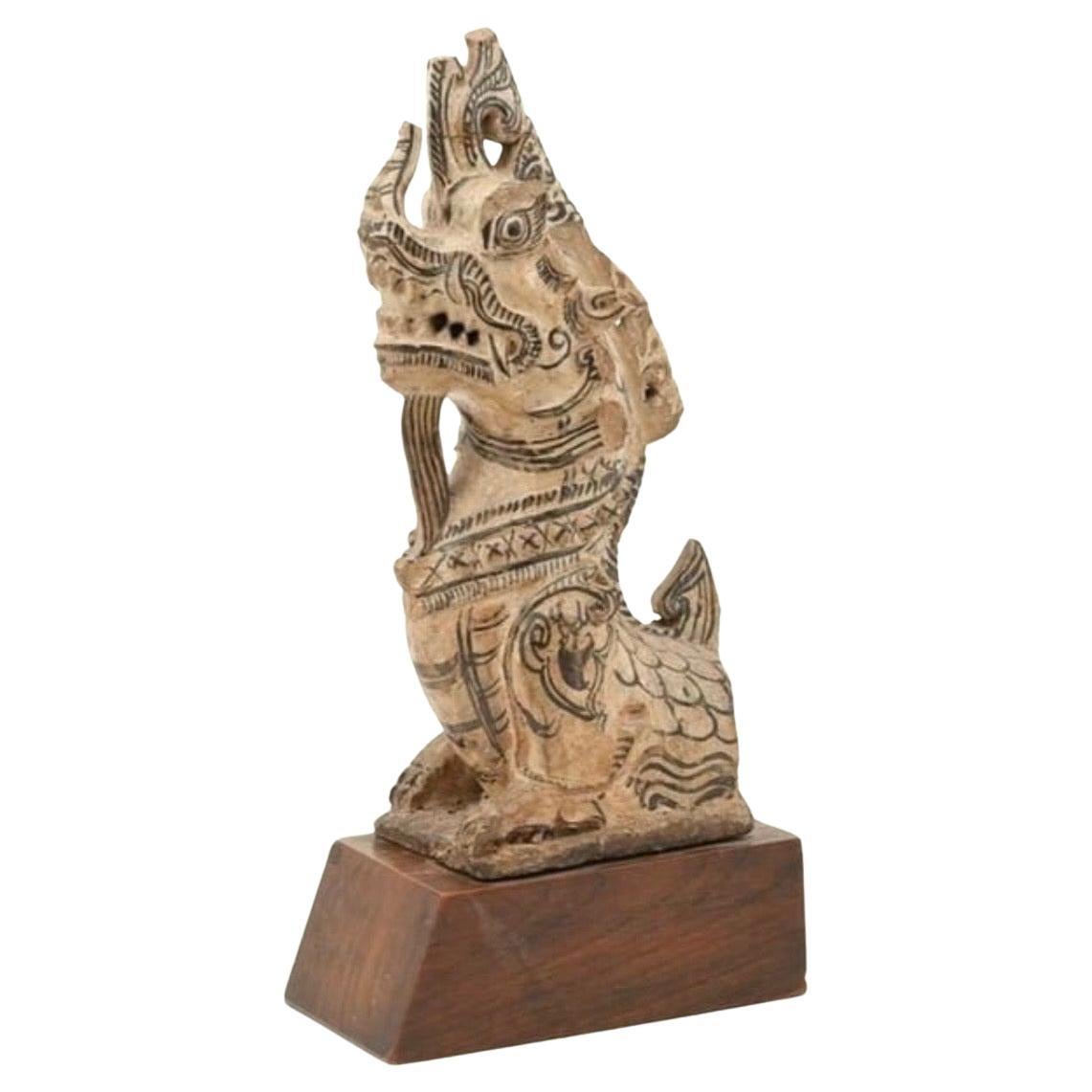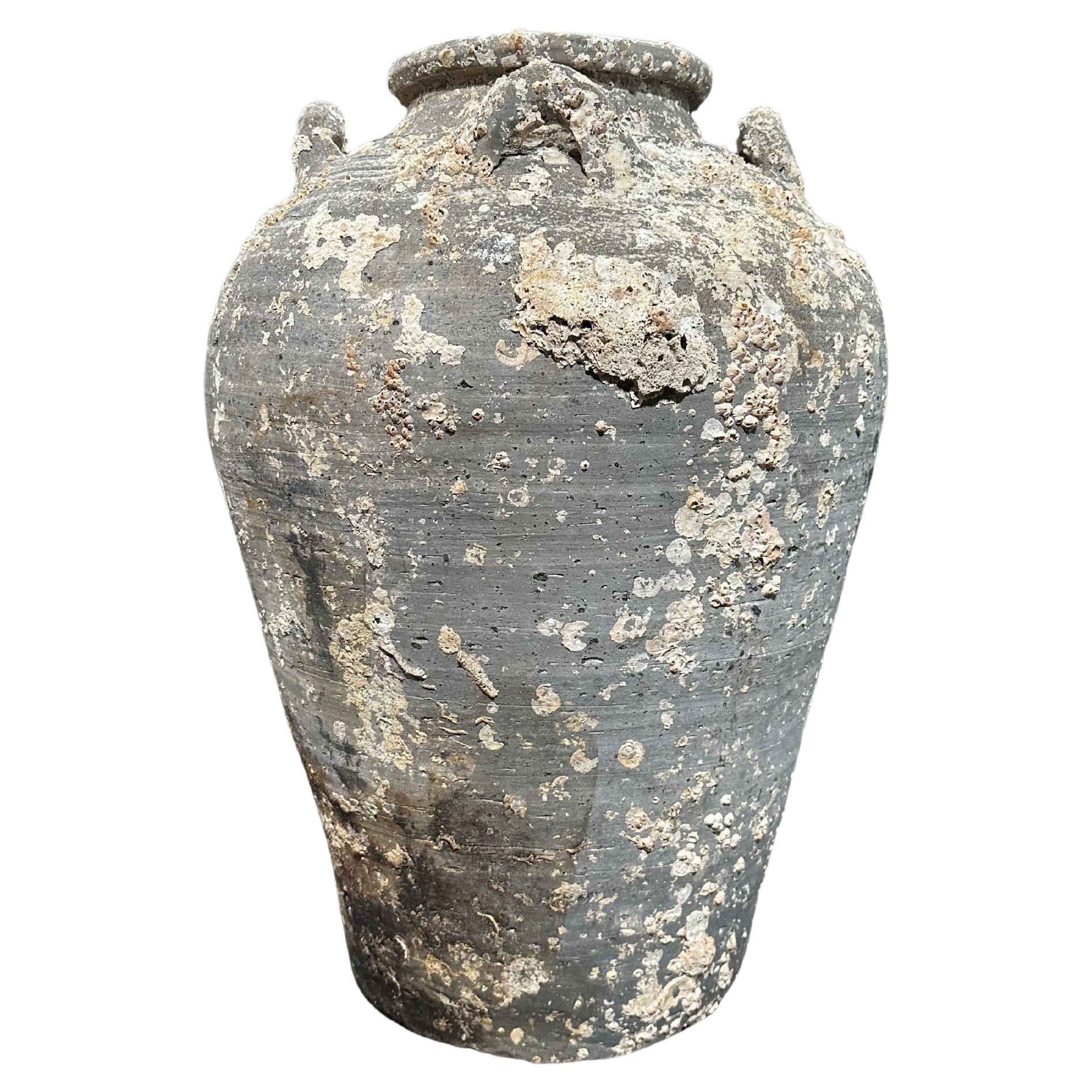Items Similar to Antique Thai Frog Shaped Kendi, Sawankhalok Kilns, Si Satchanalai.
Want more images or videos?
Request additional images or videos from the seller
1 of 17
Antique Thai Frog Shaped Kendi, Sawankhalok Kilns, Si Satchanalai.
About the Item
Antique Thai Frog Shaped Kendi, Sawankhalok Kilns, Si Satchanalai.
A squat globular stoneware body of good size having a narrow upright neck and everted mouth. The short narrow spout has the shape of an imagined frog snout. The modeled details include bulging eyes, ridge lines demarcating the spine, outline of the trunk and the legs with small webbed feet. The pot is glazed overall in a rich brown glaze lightly pitted from burial which stops short of the well trimmed foot rim revealing the beige colored biscuit.
Condition: Excellent with no knowledge or evidence of any restorations.
Age: 13th/14th century.
Size: 5.5 inches high x 5.5 inches in diameter (14 x 14cm).
Weight: 1 lb. 10.5 oz. (753g.)
Provenance:
U.S.A. art market
For similar examples see:
Museum of Anthropological Archaeology, University of Michigan at Ann Arbor, Bekker Collection UMAA 2007-8-56.
Charles Nelson Spinks, Siamese Pottery in Indonesia, fig. 42.
Charles Nelson Spinks, The Ceramic Wares of Siam, Ladejinsky collection, pl.36.
Roxanna Brown, Legend and Reality, Early Ceramics from South-East Asia, pl.180.
Note:
Sawankhalok zoomorphic kendis have mostly been found in the 20th century within the Indonesian archipelago. This may indicate that the shape, such as this frog pot would have been originally crafted as a trade ceramic destined for the islands.
- Dimensions:Height: 5.5 in (13.97 cm)Diameter: 5.5 in (13.97 cm)
- Style:Other (Of the Period)
- Materials and Techniques:
- Place of Origin:
- Period:
- Date of Manufacture:Sukhothai period (1238-1351)
- Condition:Wear consistent with age and use.
- Seller Location:Point Richmond, CA
- Reference Number:
About the Seller
4.9
Platinum Seller
These expertly vetted sellers are 1stDibs' most experienced sellers and are rated highest by our customers.
Established in 1999
1stDibs seller since 2015
604 sales on 1stDibs
Typical response time: 2 hours
- ShippingRetrieving quote...Ships From: Palm Springs, CA
- Return PolicyA return for this item may be initiated within 7 days of delivery.
More From This SellerView All
- Antique Thai Architectural Ornament, Sukhothai kilns, 15th century.Located in Point Richmond, CAAntique Thai Architectural Ornament, Sukhothai kilns, 15th century. A glazed hollow ceramic roof tile finial of the Naga/Makara Dragon torso design supported by front talons and his ...Category
Antique 15th Century and Earlier Thai Other Ceramics
MaterialsCeramic
- Antique Sawakhalok Celadon Bowl, ThailandLocated in Point Richmond, CAAntique Sawakhalok Celadon Bowl, Thailand 14th/15th century. A sturdily potted wheel thrown stoneware bowl with everted rim and flattened lip. The deep cavetto has an upper decorativ...Category
Antique 15th Century and Earlier Thai Other Ceramics
MaterialsCeramic, Celadon
- Antique Sawakhalok Celadon Bowl, ThailandLocated in Point Richmond, CAAntique Sawakhalok Celadon Bowl, Thailand 14th/15th century. A sturdily potted wheel thrown stoneware bowl with everted rim and chamfered lip. The cavetto has a three line combed dec...Category
Antique 15th Century and Earlier Thai Other Ceramics
MaterialsCeramic, Celadon
- Antique Thai Makara Ceramic Roof Tile, Sukhothai, 15th century.Located in Point Richmond, CAAntique Thai Architectural Ornament, Sukhothai kilns, 15th century. A glazed hollow ceramic roof tile finial of the Naga/Makara Dragon design having a robust chest supported by front talons and his upright bearded head with open mouth bearing his pointed teeth, further decorated in iron brown under glaze painted highlights, covered in a cream white transparent glaze. From North-Central Thailand, Sukhothai Kingdom, a 15th century sculptural architectural ornament, high-fired glazed stoneware roof tile for decorating and elaborately embellishing the roof of a Thai temple, which was generally constructed of wood and therefore long perished, leaving the remains of the roof tiles, such as this finial. Later custom fitted teak rectangular base included. Measuring: 17-3/8 in. high x 6-1/4 in. wide x 8 in. deep. (44 x 16 x 20.5cm) Weight: 10 lb. 2 oz. (4600g.) 15th Century. $4500. Provenance: with Peng Seng Antique Ltd., Bangkok 1993 (original receipt and certificate of antiquity). William R. Appleby, New York Doyle New York, Asian Works of Art September 21, 2020 lot #338. For similar examples in Museum Collections see: Asian Civilisations Museum, Singapore, accession no. C-1453. Boston Museum of Fine Arts, accession no. 2001.2 Brooklyn Museum, accession no. 84.133.5 Metropolitan Museum of Art, accession number 2019.570.0 National Gallery of Victoria. Melbourne accession no. AS86-1984. The Museum of East Asian Art, Bath, accession no. BATEA 1138. Yousef Jameel Centre for Islamic and Asian Art, Ashmolean Museum, Oxford University, accession no. EA1969.75 Asian Art Museum, San Francisco, 1990.184 For similar examples in publications see: Siamese Pottery in Indonesia, Charles Nelson Spinks, The Siam Society, Bangkok, 1959, Fig. 1. Ceramic Art of Southeast Asia, William Willets, The Southeast Asian...Category
Antique 15th Century and Earlier Thai Other Ceramics
MaterialsCeramic
- Two Laotian Clay Water Vessels (Nam Ton), Beaker & Kendi, 19th century.Located in Point Richmond, CATwo Laotian Clay Water Vessels (Nam Ton), Beaker & Kendi, 19th century. The coil built low fired clay shapes are squat globular bodies with tall handle-like necks. One is a tall beak...Category
Antique 19th Century Laotian Tribal Ceramics
MaterialsClay
- Pair of Vintage Thai Bencharong Lidded Jars, 20th century.Located in Point Richmond, CAPair of Vintage Thai Bencharong Lidded Jars, 20th century. Bencharong enamel decoration with Buddhist imagery on a black background. This porcelain jar and lid form having a raised foot rim and lotus bud on a disk lid finial are richly decorated in bright polychrome enamels in the style of the royal household ceramics favored by the nobility in eighteenth century Siam. This colorful style became known as “bencharong”, a term that derives from two Sanskrit words – panch (‘five’) and rong (‘colour’) and which relates to the number of colors used to decorate such porcelain. These jars and covers are decorated with typical Thai motifs. The sides are decorated with four Thepanom (Buddhist celestial beings) each wearing a broad necklace of petals and seated on a lotus within triangular cartouches that have a coral-red ground. Four Norasingh (mythical forest-dwelling semi-deity with a human head, torso, and arms but with the hind-quarters of a lion and the tail and hoofs of a deer) against black back grounds filled with flaming purple kranok motifs. This design is framed by two floral bands top and bottom. The interior is a covered in a transparent glaze with unglazed lid edge and the gallery interior edge of the lid unglazed. Condition: Excellent Each measuring: 5 in. in diameter x 6 in. high (12.7 x 15.2cm) Each weighing: 1 lb. 5.5 oz. (610g.) 20th century. Provenance: Dr. Philip Gould, New York, NY. Millea Brothers, New Jersey For similar examples see: William Warren & Luca Invernizzi Tettoni, Arts and Crafts of Thailand, Chronicle Books, San Francisco 1994, p.33. Bonhams New York, Indian, Himalayan & Southeast Asian Art, 17 Sep. 2014, lot 180 With the following notes: Bencharong porcelains...Category
20th Century Thai Other Ceramics
MaterialsEnamel
You May Also Like
- Antique Thai Celadon Stemmed Dish Sukhothai SawankhalokLocated in Atlanta, GAA celadon stemmed dish with underglaze deep blue decoration from Sukhothai (a former Kingdom in nowadays central Thailand) circa 14th-16th century. The pedestal dish was a typical ceramic output from Sawankhalok region, likely one of the kilns in Sri Sachanalai that thrived during 14th-15th century. Sukhothai ceramics made a large portion of export from Asia during that period due to the political policy in Ming Dynasty that banned the ocean faring (the so called Ming Gap). This stemmed dish, likely an export item, was modeled in a Classic Chinese form. The under-glaze deep blue decorations depicting the scrolling vines and flowers, as well as the archaic band around the base, are also reminiscent to the designs found in blue and white porcelain in Ming dynasty. The piece shows a fine crackles and age wear on the dish surface, an indication of appropriate patina. Under the reddish slip paint of the base, the gray paste can be discerned in small area, which is also a characteristic of the Thai celadon...Category
Antique 15th Century and Earlier Thai Archaistic Ceramics
MaterialsCeramic
- 16th Century Sawankhalok Thai Celadon DishLocated in Vosselaar, BEA large Sawankhalok dish with incised geometrical decorations. The Sawankhalok style is perhaps the most know Thai art style from the 15th and 16th century. I...Category
Antique 16th Century Thai Ceramics
MaterialsCeramic
- Sawankhalok Ship Wreck Jar from the Kingdom of Sukhothai, Thailand, 16th CenturyLocated in Jimbaran, BaliA wonderful example of a 16th Century Sawankhalok jar from a Shipwreck off the Coast of the Indonesian Island of Batam. Batam was one of the most substantial and influential ports in...Category
Antique 16th Century Thai Other Ceramics
MaterialsCeramic
- Sawankhalok Ship Wreck Jar from the Kingdom of Sukhothai, Thailand, 16th CenturyLocated in Jimbaran, BaliA wonderful example of a 16th Century Sawankhalok jar from a Shipwreck off the Coast of the Indonesian Island of Batam. Batam was one of the most substantial and influential ports in...Category
Antique 16th Century Thai Other Ceramics
MaterialsCeramic
- Thai Sawankhalok 1850s Exterior Water Jar with Distressed White PatinaLocated in Yonkers, NYA Thai Sawankhalok exterior water jar from the mid-19th century, with distressed white patina. Created in the kilns of central Thailand during the 1850s, this Sawankhalok exterior water jar attracts our attention with its nice proportions and weathered white patina accented with brown motifs, such as waves and elegant strokes. Placed outdoors or indoors, this Sawankhalok Thai water jar...Category
Antique Mid-19th Century Thai Ceramics
MaterialsCeramic
- A Massive Antique Japanese Arita Porcelain Plate by Kajiwara KilnLocated in Atlanta, GAOn offer is a truly impressive blue and white porcelain plate of Hizen ware, from Arita in Japan, circa mid to late-19th century. The plate was made by Kajiwara Kikujiro (菊次郎, the second Kiku son) and/or Kajiwara Kikusaburo (菊三郎, the third Kiku son who died in 1883) of the Kajiware Family Kiln of in Arita. It was decorated in a superb design with blue under-glaze, clearly out of a hand of a master. In a Classic Japanese composition that was popular in the Meiji Period, the plate displays a riot of auspicious elements, arranged still in a surprisingly harmonious manner. Anchoring the center of the design is an eagle perched on the branch of a blooming cherry tree, its talons clenching the bark and its wings about to open. The motion of the its immediate taking off is palpable. The trunk and the branches of the old cherry tree provide a spacial frame for the arrangement of large peonies with foliage, bundles of chrysanthemums, Chinese bell...Category
Antique 19th Century Japanese Japonisme Ceramics
MaterialsCeramic
Recently Viewed
View AllMore Ways To Browse
Antique Asian Ceramic Plates
Gosu Porcelain
Japanese Satsuma Dog
Samurai Pottery
Qing Dynasty Celadon Plate
Incense Pot
Japanese Kutani Plate
Porcelain Headrest
Voc Porcelain
Goddess Of Mercy Porcelain
Arita Kakiemon
Chinese Cockerel
Kraak Wanli
Vintage Porcelain Asian Figurines
Yuan Blue And White
Antique Yixing
Chinese Export Ducks
Japanese Platinum Gold Red Porcelain Box





